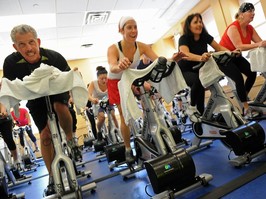by: jill barkervowing to exercise more
ranks no. 1 on more lists than any other new year’s resolution, with losing weight and eating healthier not far behind. yet despite best intentions, about 80 per cent of all january resolutions are abandoned by the end of february.does that mean setting annual health and fitness goals is a useless exercise? absolutely not. the problem often isn’t a lack of follow-through, but rather the resolution itself.to help you make the perfect resolutions to exercise more in 2022, here are six tips designed not just to get you moving, but to keep you moving all year long.
identify barriers and opportunities
there’s more than one way to realize a goal, which is why it’s important to understand what works and what doesn’t. too often we set goals without taking into consideration not only the personal barriers that hinder progress, but also the factors that influence success.ignoring the significance of time constraints, lack of motivation, unsupportive family members, financial limitations and transportation issues is short-sighted. on the flip side, it’s just as important to take into account all the factors related to success, like access to a
workplace fitness program, support from a workout buddy, a flexible work schedule and past experience. the more your resolutions match your lifestyle, the better the chances of realizing your goals.
set specific and measurable goals
instead of resolving to exercise more, set a goal of boosting your weekly exercise minutes by 10 per cent. even better, promise to increase the number of weekly workouts exceeding 30 minutes by 10 per cent. or take it one step further and vow to increase the number of weekly strength training workouts exceeding 30 minutes by 10 per cent. the more specific and measurable the goal, the easier it is to stay on track and monitor effectiveness.another benefit of measuring and monitoring the tasks at hand is being able to recognize and celebrate small wins, which can mean a lot when the final goal seems a long way off.
focus on process and performance, not just the outcome
fitness resolutions tend to land in one of three camps: outcome goals, performance goals or process goals. losing 25 pounds is an outcome goal, focusing solely on a specific result. performance goals centre on improving your personal best, like running a faster 5k, lifting a heavier weight or learning how to swim butterfly. a process goal focuses on what you need to do to achieve something, like
lifting weights three times a week to improve strength, committing to one 30-minute speed workout a week or learning all four competitive strokes.action-oriented resolutions designed to focus on self-improvement instead of self-actualization tend to be more successful. so applaud the process, not just the result.
stretch but don’t overextend
the best resolutions are goals that motivate you to dig deeper, but not so deep that you find yourself doubting your ability to achieve them. several studies of overly ambitious fitness and exercise goals have noted a short-term boost in physical activity or performance followed by a steep decline in exercise minutes. this inability to maintain positive momentum over the long haul slowly erodes confidence, which decreases the likelihood of staying committed and being successful. so while an especially big goal looks good on paper, it can be a real motivation killer.finding that sweet spot between too easy and too hard can be a challenge. but with past successes in mind, try to make the goal enticing enough that you can’t wait to get started, but not so difficult that it makes you wonder about your ability to succeed.
set short- and long-term goals
if you can’t resist setting an ambitious outcome or performance goal, then consider creating a succession of incremental and attainable short-term goals to help you move forward. like any other goal, short-term ones should be specific and measurable, setting a clear path toward the ultimate achievement. think of them as a series of strategies designed to facilitate lots of small wins on the way to a bigger win.that said, even short-term goals should offer a challenge great enough to initiate that thrill of excitement associated with taking on a new task. maintaining momentum toward a long-term goal goes a long way to discouraging the backslide synonymous with new year’s resolutions.
check in
set up predetermined checkpoints along the way to see where you stand in relation to your goal. use these to validate your progress and see if the end goal is in reach. it might help to share them with a friend or family member and discuss some of the challenges that lie ahead.it’s also a good time to be honest about your ability to meet those ambitious targets, adjusting as you see fit. there’s no shame in realigning your goals based on your actual performance. flexibility is the hallmark of good goal-setting, allowing for a better match between the exerciser and what they strive to achieve.
 4 minute read
4 minute read





